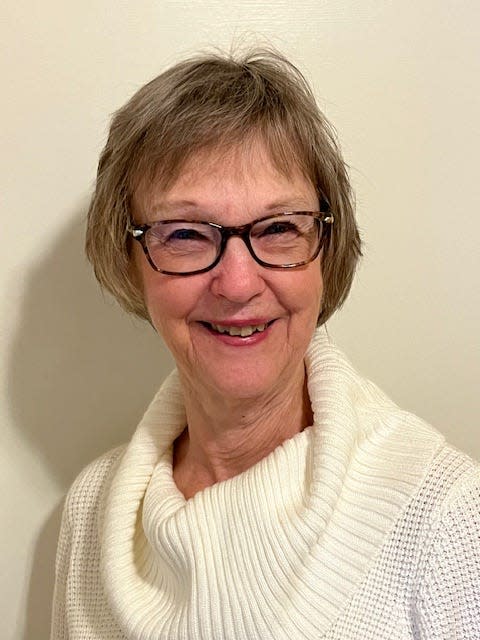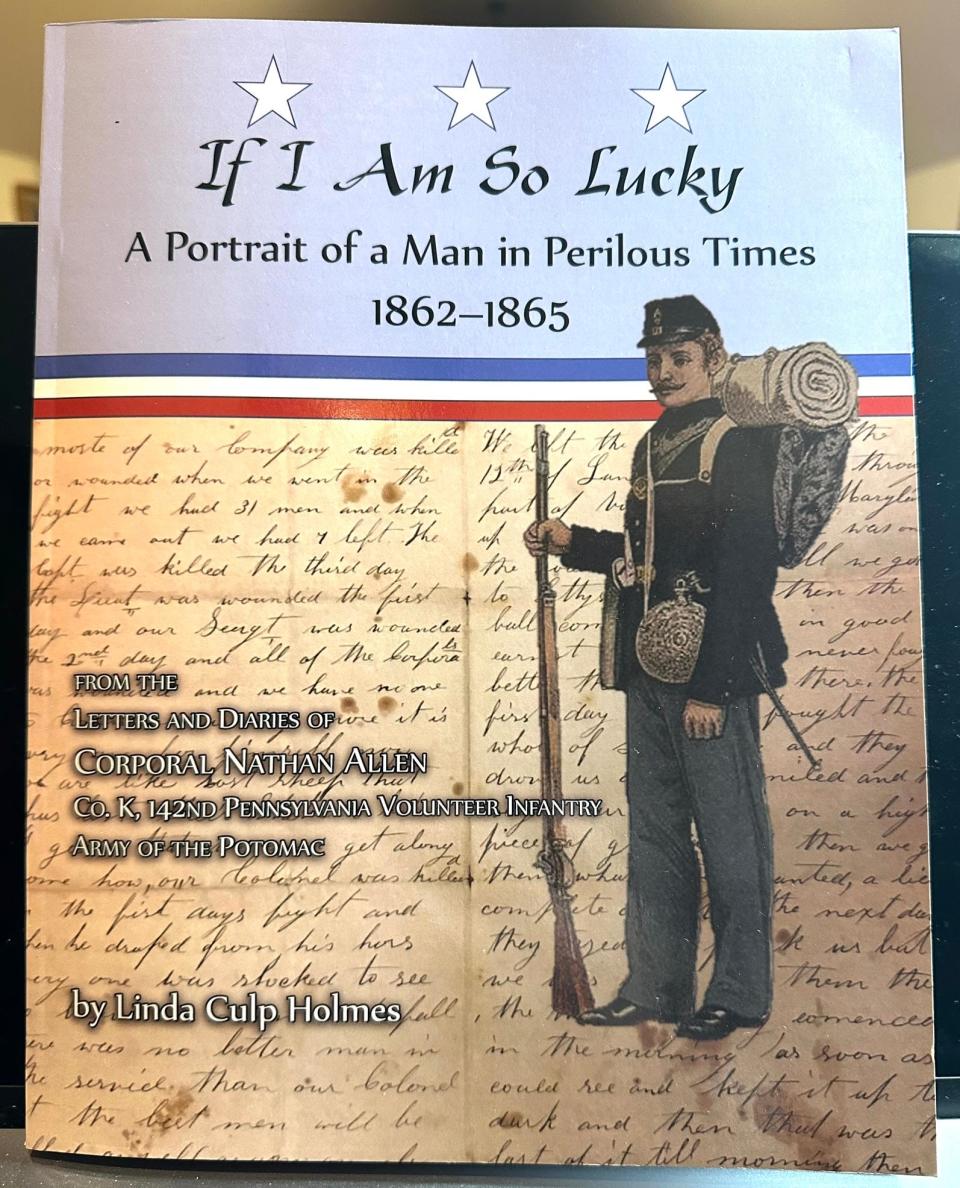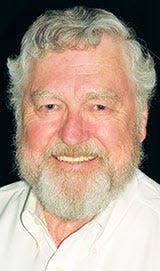'If I Am So Lucky': Oak Ridge woman writes book on ancestor's experiences in the Civil War
Linda Holmes tells us of her experience learning about a long deceased relative who had written letters and kept a diary during the Civil War. She then tells about how she went about writing a book to capture an intriguing story. I think you will enjoy it.

***
I never intended to write a book. But retirement can sometimes present a lot of possibilities and, quite unexpectedly, I found that I needed to write one after all.
What Linda Holmes did at ORAU
I retired in September 2016 after a 26-year career in the Science Education Programs unit at Oak Ridge Associated Universities. As associate director of science education, I was responsible for several groups that managed internship and postdoctoral programs for the major U.S. agencies that conduct scientific research. These programs brought students and postgraduates to these agencies to become immersed in the agencies’ missions and become part of the pool of potential employees from which those agencies could draw. Along the way, the participants enhanced their resumes and got valuable experience.
ORAU’s administration of the programs encompassed everything from conducting recruitment efforts, providing online application mechanisms, convening review panels and facilitating the selection process, paying the individuals for their participation, and conducting follow-up assessments. It was a rewarding endeavor, knowing that we were helping to enhance our nation’s science capabilities.
But in January 2017 after I spent three months getting used to the absence of 60-hour weeks, I needed a project. I remembered the letters and diaries written by my great-great uncle (oldest brother of my great-grandfather on my mother’s side) during his service in the Union Army from 1862-1865. These letters and diaries had been languishing for nearly 160 years, most recently in a cupboard in my basement! I thought to myself that now would be a great time to do something with them.
Everyone before me had dutifully kept them, but no one did anything about preserving them or their content. The paper was disintegrating and the pencil and pen fading. Soon there would be nothing left of this fantastic historical record. I knew it was up to me to save the words of my ancestor who took the time to chronicle his experience.
The work on the book begins; the value of online information
So, I set about capturing the content. Save the letters and diaries from the ravages of time. That was all. I didn’t know anything about the writer or about the Civil War for that matter. Along the way, I got curious. And it was a curiosity that wouldn’t go away. There was so much in the letters and diaries that needed explaining. So many events, battles, policies. So much ugly politics. So many people I didn’t know. Not to mention a whole new vocabulary.
And so, what started out as a transcription of this man’s words into a more permanent medium became a full-blown research project – one that took six and one-half years. I wanted to know everything about this soldier – where he went, what he was doing, who he was with, and who he wrote to. Above all, I wanted to know the man who wrote these words so long ago and to understand the time in which he lived.
The soldier’s name was Nathan Allen. He was 25, the oldest of 10 children, when he joined the 142nd Pennsylvania Volunteer Infantry because, like so many of his friends, he believed in the cause of preserving the Union. That was in August 1862 after the war was already more than a year old. His father owned a 50-acre farm that raised potatoes, apples, and grain as the family business. Nathan couldn’t have been less prepared for war. But go to war he did.
After carefully reading Nathan’s every word, I learned the kind of man he was. I learned about his most treasured beliefs, the value his friends and family brought to his life, the illnesses he suffered, the devastating loss of close friends and extended family in such a cruel war, what happened to him during the Battle of Fredericksburg, and how he felt about his commanding officers and the top generals of the Union Army.
I relished learning how he traveled from place to place, how he acquired items beyond the government issued food and equipment, how he reacted to Black soldiers joining the Union Army, how he dealt with the anti-war sentiment in his hometown, what happened to his friends and colleagues, what medical care he received, what he ate and how he felt about Uncle Sam’s rations, and the strong belief in God that he asked to carry him safely home.
Along the way, I researched many of the topics that intersected with Nathan’s experience – topics such as the process of parole, methods of army recruitment, the prevalence of guerrilla warfare, the mechanism that delivered army rations, the election of 1864, the disruptive activities of anti-war protesters, the cost of farm products and sutler merchant wares, the role of Black soldiers in the war effort, the accuracy of Civil War weaponry, the problem of desertion, the role of the color bearers on the battlefield, public reaction to the draft and ways to avoid it, the existence of volunteer organizations to help soldiers, the soldiers’ use of an express system to send home their pay, and the contributions of the U.S. Balloon Corps, among others. Every day brought me new and exciting information about Nathan, the war, and 19th century life in general.
So, how did I find out about all these things? By reading a lot of books and portions of books, (including transcriptions of the letters and diaries of other soldiers in the 142nd), but mostly by accessing all the records that are available online – maps of battles showing exactly where the 142nd was located; official records that told, for example, the exact route the 142nd followed in their march from the Fredericksburg area to Gettysburg; communications between generals that determined where the 142nd was to be sent; information from national battlefield parks; records of all the soldiers in the Pennsylvania infantry, artillery, and cavalry; the ancestry.com database where I found all but a couple of the 150 people Nathan mentioned in his correspondence; and newspapers.com where I could read letters from Nathan’s colleagues sent to their home newspapers about the regiment’s experiences.
There were so many resources online that I barely had to pick up a book. Had I attempted this project 40 years ago, I would have had to travel far and wide to collect the same information that was now at my fingertips on the computer.
So, with all this research, a book started to emerge. There are literally thousands of books written about the Civil War. What did I have to add? Nothing about the war itself, the battles, strategies, tactics, politics, leadership personalities. But I could illuminate Nathan Allen, what he thought, feared, and treasured. And I could explain all the things he talked about – parole, copperheads, Libby Prison, picket duty and on and on. I knew I had something unique in that all other books based on soldiers’ letters and diaries publish the content itself without explaining any of the references the writers make to events and people. The result is that readers must do their own research. I wanted my readers to have the benefit of what I learned. So, it’s all included in the book – in text boxes, sidebars, and footnotes to enhance the main text.
When my book was mostly written, I began to shop it around. It took me a while to figure out where it belonged. It is not a book of Civil War scholarship that shows some new aspect of a battle or a famous pe-son. It occupies a unique niche of social history and genealogy. Once I understood that, I was able to find a publisher who was interested in publishing and marketing it. My book is about a man in the context of a horrific war and in the context of 19th century society. The man as well as all the things he wrote about are the message.
As I began to prepare the manuscript for publishing, I had to learn a lot about Microsoft Word, dealing with textboxes, page numbering, pagination, and endnotes. Because of all the people Nathan mentioned in his letters and diaries, I also had to learn how to code an index. Then I needed to brush up on writing a preface and an introduction and prepare acknowledgments.
When I struggled to figure out some aspect of manuscript preparation, Google became my best friend. I also had to enlist the help of a cartographer who could provide maps that showed exactly where Nathan’s regiment was stationed during all the battles in which he participated. And I needed to engage an index checker and copy editor to point out typos and grammar faux pas and to school me on the finer points of the Chicago Manual of Style.
In his letters home, Nathan continually said he would like to do something special when he got home after his three-year stint in the army was up.
“If,” he said, “I am so lucky.”
So, that became the title of the book: “If I Am So Lucky: A Portrait of a Man in Perilous Times, 1862-1865. It is published by Heritage Books Inc. and is available on their website at www.heritagebooks.com and at Amazon.

Studying Nathan’s journey and making one of my own was a labor of love and an enlightening task. After immersing myself in the Civil War – a particularly ugly chapter in our history that seems to have echoes in current times – I found one inescapable take-away: We must study history – learn about it, understand it, and embrace it, the good, the bad, and the ugly. because knowledge of our past may be the only antidote to making the same mistakes our forebears made.
***
Thanks, Linda, for a most interesting story. I highly recommend the book, "If I Am So Lucky." While it is based on letters and diary content, the book is far more than that. It explains much about the Civil War and includes in-depth analysis of many aspects of that war. The focus is on the 142nd Pennsylvania Volunteer Infantry but application can be made to many other units and battles than the ones fought by Nathan Allen. I encourage you if you have any interest in the Civil War to consider this very detailed and comprehensive book that so eloquently conveys the atmosphere that existed during that awful time of war.

This article originally appeared on Oakridger: Oak Ridger writes book on ancestor's experiences in the Civil War

